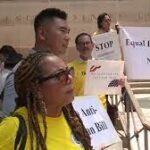Footy forgetting what’s important amid Hawkins and Naitanui controversies

The AFL has endured an agonising debate about changes to the way the game is played. Yet there are some innovations that are as obviously beneficial as the drop punt.
We cannot protect top-level umpires from the mindless abuse of crowds or the second-guessing of media critics. But we can ensure the young umpire blowing the whistle at a junior game feels like the game has his back.
Thus even those who might otherwise have thought "sacrosanct" was an artificial sweetener use the word in one context — the umpire is sacrosanct.
At a local level the message is written on clubhouse walls — don't dispute the umpire's decision, don't abuse the umpire and, most importantly, never ever touch the umpire.
So when Geelong forward Tom Hawkins reached out in frustration and put his hands on an umpire during the Cats' game against Greater Western Sydney, everyone in the AFL world joined the chorus of condemnation.
Right? Of course not.
Instead, Hawkins' former captain Cameron Ling, in his guise as a television commentator, trivialised the offence suggesting it deserved only a small fine.
Others with an affiliation to the Cats, or harbouring the hoary notion umpires are subservient to the superstars with whom they share the field, ignored years of cautionary tales — the many stories about suburban umpires attacked by disgruntled players and cowardly fans — and sought ways to absolve Hawkins or to shift the blame ("why did the umpire need to get that close to Tom? He was provoked!").
A false narrative about Hawkins touching the umpire as the result of a misdirected high five was floated and Geelong coach Chris Scott mounted a defence of Hawkins' character when the big forward's character had not been questioned.
This said more about the absurdity of asking a coach about a reported player's guilt than about the case itself.
So by the time Hawkins appeared at the tribunal he was, to some, a martyr to the cause of player infallibility. Not an otherwise good natured man who had made a reflexive but serious mistake.
And the umpire? No longer sacrosanct if it meant Tommy copped a week.
Remember those concerns over concussion?
Another change we have taken for granted is that the rules of all football codes must be framed and enforced to protect the head.
The term chronic traumatic encephalopathy hasn't quite crept into the Australian sporting lexicon like sacrosanct. But it should ring a bell, much like the one ringing in the heads of the serially-concussed American footballers who suffer the awful symptoms of CTE.
We've seen the documentaries about these sad hulks who can't remember where they live, let alone their PIN numbers, after taking blow after concussive blow on their helmeted heads.
We've seen the first of the dazed Australian footballers from various codes — even soccer players who made too many headers — shuffle forward seeking cures and compensation for the cruel fate their game has inflicted upon them.
So we vow that we won't let our children suffer the same fate. This means when West Coast ruckman Nic Natanui takes Port Adelaide's Karl Amon forward in a tackle and Amon's head hits the ground, we must make a call.
We can default to the long-held belief that Natanui was merely attempting to tackle in the legitimate manner and thus, while he pushed Amon in the back, should be afforded the protection of a century of precedent.
Or we can take the more enlightened approach that Natanui made a choice in pushing forward in that tackle instead of rolling the player to the side and is therefore responsible for the outcome — Amon's concussion — in the hope this minimises similar incidents.
This was, admittedly, a line ball case. Natanui does not sling or spear-tackle Amon. But if the AFL wants to walk the walk on serious head injuries it must consider the consequences as well as the action, as it does with bumps, and change its default setting.
And yet by Wednesday night's tribunal hearing Natanui, like Hawkins, had been cast by some as the victim. Even by those who had previously highlighted and bemoaned the perils of CTE.
The AFL did not help its own cause. Clearing Hawthorn's Ryan Burton after North Melbourne's Shaun Higgins suffered serious concussion in a bump this season muddied the waters around the liability of players bumping and tackling.
Similarly, the AFL advocate's claim that the 201cm Natanui had a responsibility to be aware of the size discrepancy with the 181cm Amon was an obvious red herring and only helped feed the "Free Nic-Nat" hysteria.
Although those who claimed Natanui was now "disadvantaged by his size" might want to watch the 201cm ruckman soar above opponents with the leap of a prima ballerina and have another think.
Inevitably, despite the backlash, both Hawkins and Natanui were suspended for one week, bans that will inconvenience their teams but serve the game's greater cause well.
In that regard, the words of the players were more responsible than those of some disgruntled fans, ex-players and old school media diehards who had abandoned the principle of protecting the umpires and the head at the first hurdle.
After pleading guilty, Hawkins spoke graciously.
He accepted his punishment had helped underscore that old message — the umpire is, indeed, sacrosanct.
Natanui remained bemused by his suspension. But his tweeted message was a welcome counter to the absurd hysteria of those commentators laughably claiming "the tackle is dead".
"Obviously disappointed but ain't no point complaining about it. Starvation/homelessness are real issues. We smile and move on," he tweeted.
[contf]
[contfnew]
ABC .net
[contfnewc]
[contfnewc]





















